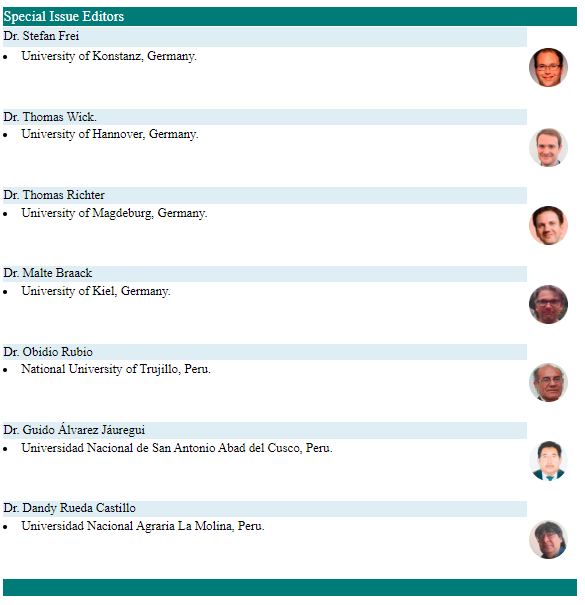Frobenius methods for analytic second order linear partial differential equations
DOI:
https://doi.org/10.17268/sel.mat.2023.02.01Palabras clave:
Frobenius method, regular singularity, analytic solutions, partial differential equationResumen
The main subject of this text is the study of analytic second order linear partial differential equations. We aim to solve the classical equations and some more, in the real or complex analytical case. This is done by introducing methods inspired by the method of Frobenius method for second order linear ordinary differential equations. We introduce a notion of Euler type partial differential equation. To such a PDE we associate an indicial conic, which is an affine plane curve of degree two. Then comes the concept of regular singularity and finally convergence theorems, which must necessarily take into account the type of PDE (parabolic, elliptical or hyperbolic) and a nonresonance condition. This condition gives a new geometric interpretation of the original condition between the roots of the original Frobenius theorem for second order ODEs. The interpretation is something like, a certain reticulate has or not vertices on the indexical conic. Finally, we retrieve the solution of all the classical PDEs by this method (heat diffusion, wave propagation and Laplace equation), and also increase the class of those that have explicit algorithmic solution to far beyond those admitting separable variables. The last part of the text is dedicated to the construction of PDE models for the classical ODEs like Airy, Legendre, Laguerre, Hermite and Chebyshev by two different means. One model is based on the requirement that the restriction of the PDE to lines through the origin must be the classical ODE model. The second is based on the idea of having symmetries on the PDE model and imitating the ODE model. We study these PDEs and obtain their solutions, obtaining for the framework of PDEs some of the classical results, like existence of polynomial solutions (Laguerre, Hermite and Chebyshev polynomials).
Citas
Borthwick D. Introduction to Partial Differential Equations. Cham: Springer; 2016. 285 p.
Frobenius G. Ueber die Integration der linearen Differentialgleichungen durch Reihen. Journal für die Reine und Angewandte Mathematik. 1873; 76: 214–235.
Boyce WE, DiPrima RC. Elementary Differential Equations and Boundary Value Problems. 10a ed. New York: John Wiley & Sons; 2012. 672 p.
Coddington EA. An Introduction to Ordinary Differential Equations. New York: Dover Publications; 1989. 292 p.
León V, Rodriguez A, Scárdua B. Analysis of third order linear analytic differential equations with a regular singularity: Bessel and other classical equations. Annals of Mathematical Sciences and Applications. 2021; 6(1): 51–83.
Griffiths D. Introduction to Quantum Mechanics. 2a ed. New Jersey: Person Prentice Hall; 2005. 484 p.
Bethe HA, Salpeter EE. Quantum Mechanics of One- and Two-Electron Atoms. Berlin: Springer-Verlag; 1957. 369 p.
Hua LK. Introduction to Number Theory. Berlin, Heidelberg and New York: Springer-Verlag; 1982. 574 p.
León V, Scárdua B. A complete Frobenius type method for linear partial differential equations of third order. Differential Equations & Applications. 2021; 13(2): 115–149.
Matthews K. Solving the diophantine equation ax2 + bxy + cy2 + dx + ey + f = 0. Available from http://www.numbertheory.org/PDFS/general_quadratic_solution.pdf
Descargas
Publicado
Cómo citar
Número
Sección
Licencia
Derechos de autor 2023 Selecciones Matemáticas

Esta obra está bajo una licencia internacional Creative Commons Atribución 4.0.
Los autores/as que publiquen en esta revista aceptan las siguientes condiciones:
- Los autores/as conservan los derechos de autor y ceden a la revista el derecho de la primera publicación, con el trabajo registrado con la licencia de atribución de Creative CommonsAtribución 4.0 Internacional (CC BY 4.0) , que permite a terceros utilizar lo publicado siempre que mencionen la autoría del trabajo y a la primera publicación en esta revista.
- Los autores/as pueden realizar otros acuerdos contractuales independientes y adicionales para la distribución no exclusiva de la versión del artículo publicado en esta revista (p. ej., incluirlo en un repositorio institucional o publicarlo en un libro) siempre que indiquen claramente que el trabajo se publicó por primera vez en esta revista.
- Se permite y recomienda a los autores/as a publicar su trabajo en Internet (por ejemplo en páginas institucionales o personales) antes y durante el proceso de revisión y publicación, ya que puede conducir a intercambios productivos y a una mayor y más rápida difusión del trabajo publicado(Consultar: efecto del acceso abierto).













